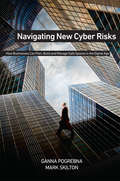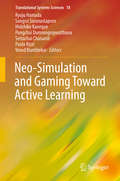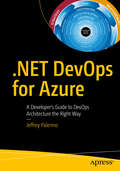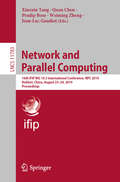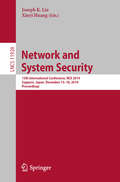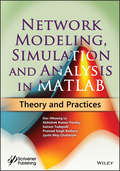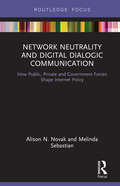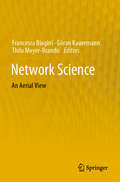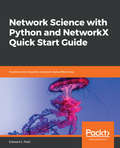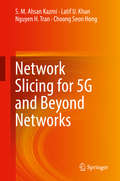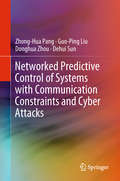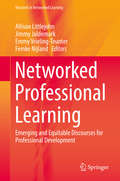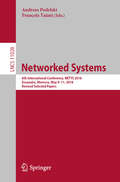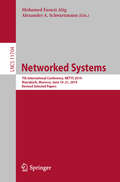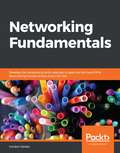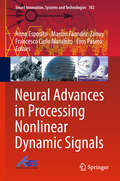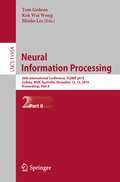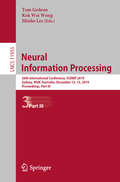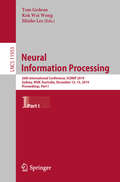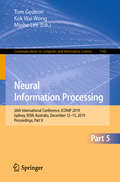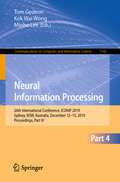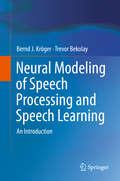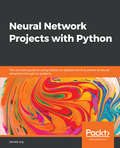- Table View
- List View
Navigating New Cyber Risks: How Businesses Can Plan, Build and Manage Safe Spaces in the Digital Age
by Ganna Pogrebna Mark SkiltonThis book is a means to diagnose, anticipate and address new cyber risks and vulnerabilities while building a secure digital environment inside and around businesses. It empowers decision makers to apply a human-centred vision and a behavioral approach to cyber security problems in order to detect risks and effectively communicate them. The authors bring together leading experts in the field to build a step-by-step toolkit on how to embed human values into the design of safe human-cyber spaces in the new digital economy. They artfully translate cutting-edge behavioral science and artificial intelligence research into practical insights for business. As well as providing executives, risk assessment analysts and practitioners with practical guidance on navigating cyber risks within their organizations, this book will help policy makers better understand the complexity of business decision-making in the digital age. Step by step, Pogrebna and Skilton show you how to anticipate and diagnose new threats to your business from advanced and AI-driven cyber-attacks.
Neo-Simulation and Gaming Toward Active Learning (Translational Systems Sciences #18)
by Hidehiko Kanegae Paola Rizzi Ryoju Hamada Songsri Soranastaporn Pongchai Dumrongrojwatthana Settachai Chaisanit Vinod DumblekarThis book provides tips to teachers for moving toward active learning by using simulation and gaming. The book is a rare reference for teachers who wish to initiate active learning by applying many real experiences from world experts in simulation and gaming. This cumulative wisdom comes from cutting-edge trials reported at the 49th International Simulation and Gaming Association’s annual conference in Thailand 9–13 July 2018. The importance of changing teachers’ one-way lecture approach to that of active learning has been commonly understood for several decades and has been promoted especially in recent years in Asian universities. Simulation and gaming meets the requirements of such teaching programs, especially for active learning, but there are few books or references on how to gamify a lecture. This book serves as a guide to facilitate that change. The author recognizes the duty to provide readers with fixed directions toward simulation and gaming in the next generation, which have still not been fully elucidated. Developing a simulation and gaming culture and making it sustainable in the next decade are the purpose of this book.
The NES Encyclopedia: Every Game Released for the Nintendo Entertainment System
by Chris ScullionA comprehensive, colorful guide to every game ever released on the classic Nintendo Entertainment System. One of the most iconic video game systems, the NES is credited with saving the American video games industry in the early 1980s. The NES Encyclopedia is the first ever complete reference guide to every game released on the Nintendo Entertainment System, Nintendo&’s first industry-defining video game system. As well as covering all 714 officially licensed NES games, the book also includes more than 160 unlicensed games released during its lifespan, giving for the first time a definitive history of this important console's full library. Written by a retro gaming expert with 30 years of gaming experience and a penchant for bad jokes, TheNES Encyclopedia promises to be both informative and entertaining. The NES continues to enjoy a strong cult following among Nintendo fans and gamers in general with wide varieties of officially licensed merchandise proving ever popular. Nintendo&’s most recent console, the Switch, is the fastest selling video game console of all time in the United States and Japan. Nintendo launched a variety of classic NES games for download on the system, meaning a new audience of gamers is due to discover the NES for the first time if they have not already. Praise for The NES Encyclopedia &“As a catalog of all 876 NES games, this work is unique in its breadth of coverage and will be of great interest to old-school video gamers and collectors.&” —Booklist &“A definitive resource that is more than worthy of the title &‘Encyclopedia.&’ &” —Nintendo World Report
.NET DevOps for Azure: A Developer's Guide to DevOps Architecture the Right Way
by Jeffrey PalermoUse this book as your one-stop shop for architecting a world-class DevOps environment with Microsoft technologies..NET DevOps for Azure is a synthesis of practices, tools, and process that, together, can equip a software organization to move fast and deliver the highest quality software. The book begins by discussing the most common challenges faced by developers in DevOps today and offers options and proven solutions on how to implement DevOps for your team.Daily, millions of developers use .NET to build and operate mission-critical software systems for organizations around the world. While the marketplace has scores of information about the technology, it is completely up to you to put together all the blocks in the right way for your environment.This book provides you with a model to build on. The relevant principles are covered first along with how to implement that part of the environment. And while variances in tools, language, or requirements will change the needed implementation, the DevOps model is the architecture for the working environment for your team. You can modify parts of the model to customize it to your enterprise, but the architecture will enable all of your teams and applications to accelerate in performance.What You Will LearnGet your .NET applications into a DevOps environment in AzureAnalyze and address the part of your DevOps process that causes delays or bottlenecksTrack code using Azure Repos and conduct acceptance testsApply the rules for segmenting applications into Git repositoriesUnderstand the different types of builds and when to use eachKnow how to think about code validation in your DevOps environmentProvision and configure environments; deploy release candidates across the environments in AzureMonitor and support software that has been deployed to a production environmentWho This Book Is For.NET Developers who are using or want to use DevOps in Azure but don’t know where to begin
Network and Parallel Computing: 16th IFIP WG 10.3 International Conference, NPC 2019, Hohhot, China, August 23–24, 2019, Proceedings (Lecture Notes in Computer Science #11783)
by Quan Chen Xiaoxin Tang Pradip Bose Weiming Zheng Jean-Luc GaudiotThis book constitutes the proceedings of the 16th IFIP WG 10.3 International Conference on Network and Parallel Computing, NPC 2019, held in Hohhot, China, in August 2019. The 22 full and 11 short papers presented in this volume were carefully reviewed and selected from 107 submissions. They were organized in topical sections named: graph computing; NOC and networks; neural networks; big data and cloud; HPC; emerging topics; memory and file system.
Network and System Security: 13th International Conference, NSS 2019, Sapporo, Japan, December 15–18, 2019, Proceedings (Lecture Notes in Computer Science #11928)
by Xinyi Huang Joseph K. LiuThis book constitutes the proceedings of the 13th International Conference on Network and System Security, NSS 2019, held in Sapporo, Japan, in December 2019. The 36 full papers and 7 short papers presented together with 4 invited papers in this book were carefully reviewed and selected from 89 initial submissions. The papers cover a wide range of topics in the field, including authentication, access control, availability, integrity, privacy, confidentiality, dependability and sustainability of computer networks and systems.
Network Flow Algorithms
by David P. WilliamsonNetwork flow theory has been used across a number of disciplines, including theoretical computer science, operations research, and discrete math, to model not only problems in the transportation of goods and information, but also a wide range of applications from image segmentation problems in computer vision to deciding when a baseball team has been eliminated from contention. This graduate text and reference presents a succinct, unified view of a wide variety of efficient combinatorial algorithms for network flow problems, including many results not found in other books. It covers maximum flows, minimum-cost flows, generalized flows, multicommodity flows, and global minimum cuts and also presents recent work on computing electrical flows along with recent applications of these flows to classical problems in network flow theory.
Network Modeling, Simulation and Analysis in MATLAB: Theory and Practices
by Dac-Nhuong Le Abhishek Kumar Pandey Sairam Tadepalli Pramod Singh Rathore Jyotir Moy ChatterjeeThe purpose of this book is first to study MATLAB programming concepts, then the basic concepts of modeling and simulation analysis, particularly focus on digital communication simulation. The book will cover the topics practically to describe network routing simulation using MATLAB tool. It will cover the dimensions’ like Wireless network and WSN simulation using MATLAB, then depict the modeling and simulation of vehicles power network in detail along with considering different case studies. Key features of the book include: Discusses different basics and advanced methodology with their fundamental concepts of exploration and exploitation in NETWORK SIMULATION. Elaborates practice questions and simulations in MATLAB Student-friendly and Concise Useful for UG and PG level research scholar Aimed at Practical approach for network simulation with more programs with step by step comments. Based on the Latest technologies, coverage of wireless simulation and WSN concepts and implementations
Network Neutrality and Digital Dialogic Communication: How Public, Private and Government Forces Shape Internet Policy (Routledge Studies in Media Law and Policy)
by Alison N. Novak Melinda SebastianIn the months after the Federal Communications Commission’s (FCC) 2017 decision to repeal network neutrality as US policy, it is easy to forget the decades of public, organizational, media and governmental struggle to control digital policy and open access to the internet. Using dialogic communication tactics, the public, governmental actors and organizations impacted the ruling through YouTube comments, the FCC online system and social network communities. Network neutrality, which requires that all digital sites can be accessed with equal speed and ability, is an important example of how dialogic communication facilitates public engagement in policy debates. However, the practice and ability of the public, organizations and media to engage in dialogic communication are also greatly impacted by the FCC’s decision. This book reflects on decades of global engagement in the network neutrality debate and the evolution of dialogic communication techniques used to shape one of the most relevant and critical digital policies in history.
Network Science: An Aerial View
by Francesca Biagini Göran Kauermann Thilo Meyer-BrandisThis book provides an overview of network science from the perspective of diverse academic fields, offering insights into the various research areas within network science. The authoritative contributions on statistical network analysis, mathematical network science, genetic networks, Bayesian networks, network visualisation, and systemic risk in networks explore the main questions in the respective fields: What has been achieved to date? What are the research challenges and obstacles? What are the possible interconnections with other fields? And how can cross-fertilization between these fields be promoted? Network science comprises numerous scientific disciplines, including computer science, economics, mathematics, statistics, social sciences, bioinformatics, and medicine, among many others. These diverse research areas require and use different data-analytic and numerical methods as well as different theoretical approaches. Nevertheless, they all examine and describe interdependencies, associations, and relationships of entities in different kinds of networks. The book is intended for researchers as well as interested readers working in network science who want to learn more about the field – beyond their own research or work niche. Presenting network science from different perspectives without going into too much technical detail, it allows readers to gain an overview without having to be a specialist in any or all of these disciplines.
Network Science with Python and NetworkX Quick Start Guide: Explore and visualize network data effectively
by Edward L. PlattManipulate and analyze network data with the power of Python and NetworkXKey FeaturesUnderstand the terminology and basic concepts of network scienceLeverage the power of Python and NetworkX to represent data as a networkApply common techniques for working with network data of varying sizesBook DescriptionNetworkX is a leading free and open source package used for network science with the Python programming language. NetworkX can track properties of individuals and relationships, find communities, analyze resilience, detect key network locations, and perform a wide range of important tasks. With the recent release of version 2, NetworkX has been updated to be more powerful and easy to use.If you’re a data scientist, engineer, or computational social scientist, this book will guide you in using the Python programming language to gain insights into real-world networks. Starting with the fundamentals, you’ll be introduced to the core concepts of network science, along with examples that use real-world data and Python code. This book will introduce you to theoretical concepts such as scale-free and small-world networks, centrality measures, and agent-based modeling. You’ll also be able to look for scale-free networks in real data and visualize a network using circular, directed, and shell layouts.By the end of this book, you’ll be able to choose appropriate network representations, use NetworkX to build and characterize networks, and uncover insights while working with real-world systems.What you will learnUse Python and NetworkX to analyze the properties of individuals and relationshipsEncode data in network nodes and edges using NetworkXManipulate, store, and summarize data in network nodes and edgesVisualize a network using circular, directed and shell layoutsFind out how simulating behavior on networks can give insights into real-world problemsUnderstand the ongoing impact of network science on society, and its ethical considerationsWho this book is forIf you are a programmer or data scientist who wants to manipulate and analyze network data in Python, this book is perfect for you. Although prior knowledge of network science is not necessary, some Python programming experience will help you understand the concepts covered in the book easily.
Network Slicing for 5G and Beyond Networks
by S. M. Kazmi Latif U. Khan Nguyen H. Tran Choong Seon HongThis book provides a comprehensive guide to the emerging field of network slicing and its importance to bringing novel 5G applications into fruition. The authors discuss the current trends, novel enabling technologies, and current challenges imposed on the cellular networks. Resource management aspects of network slicing are also discussed by summarizing and comparing traditional game theoretic and optimization based solutions. Finally, the book presents some use cases of network slicing and applications for vertical industries. Topics include 5G deliverables, Radio Access Network (RAN) resources, and Core Network (CN) resources. Discusses the 5G network requirements and the challenges therein and how network slicing offers a solutionFeatures the enabling technologies of future networks and how network slicing will play a rolePresents the role of machine learning and data analytics for future cellular networks along with summarizing the machine learning approaches for 5G and beyond networks
Networked Predictive Control of Systems with Communication Constraints and Cyber Attacks
by Zhong-Hua Pang Guo-Ping Liu Donghua Zhou Dehui SunThis book presents the latest results on predictive control of networked systems, where communication constraints (e.g., network-induced delays and packet dropouts) and cyber attacks (e.g., deception attacks and denial-of-service attacks) are considered. For the former, it proposes several networked predictive control (NPC) methods based on input-output models and state-space models respectively. For the latter, it designs secure NPC schemes from the perspectives of information security and real-time control. Furthermore, it uses practical experiments to demonstrate the effectiveness and applicability of all the methods, bridging the gap between control theory and practical applications. The book is of interest to academic researchers, R&D engineers, and graduate students in control engineering, networked control systems and cyber-physical systems.
Networked Professional Learning: Emerging and Equitable Discourses for Professional Development (Research in Networked Learning)
by Allison Littlejohn Jimmy Jaldemark Emmy Vrieling-Teunter Femke NijlandOver the past decades a new form of professionalism has emerged, characterized by factors of fluidity, instability and continual change, leading to the necessitation of new forms of professional development that support agile and flexible expansion of professional practice. At the same time, the digitization of work has had a profound effect on professional practice. This digitization opens up opportunities for new forms of professional learning mediated by technologies through networked learning. Networked learning is believed to lead to a more efficient flow of complex knowledge and routine information within the organization, stimulate innovative behaviour, and result in a higher job satisfaction. In this respect, networked learning can be perceived as an important perspective on both professional and organizational development. This volume provides examples of Networked Professional Learning, it questions the impact of this emerging form of learning on the academy, and it interrogates the impact on teachers of the future. It features three sections that explore networked professional learning from different perspectives: questioning what legitimate forms of networked professional learning are across a broad sampling of professions, how new forms of professional learning impact institutions of higher education, and the value creation that Networked Learning offers professionals in broader educational, economic, and social contexts. The book is of interest to researchers in the area of professional and digital learning, higher education managers, organizational HR professionals, policy makers and students of technology enhanced learning.
Networked Systems: 6th International Conference, NETYS 2018, Essaouira, Morocco, May 9–11, 2018, Revised Selected Papers (Lecture Notes in Computer Science #11028)
by Andreas Podelski François TaïaniThis book constitutes the thoroughly refereed conference proceedings of the 6th International Conference on Networked Systems, NETYS 2018, held in Essaouira, Morocco, in May 2018. The 22 full and 6 short papers presented together with 11 keynotes and 2 invited papers were carefully reviewed and selected from 85 submissions. They are organized in the following topics: distribution; concurrency; verification; networking; self-stabilization; security; graph; and middleware.
Networked Systems: 7th International Conference, NETYS 2019, Marrakech, Morocco, June 19–21, 2019, Revised Selected Papers (Lecture Notes in Computer Science #11704)
by Mohamed Faouzi Atig Alexander A. SchwarzmannThis book constitutes the revised selected papers of the 7th International Conference on Networked Systems, NETYS 2019, held in Marrakech, Morocco, in June 2019. The 23 revised full papers and 3 short papers presented were carefully reviewed and selected from 60 submissions. The papers are organized in the following topics: formal verification, distributed systems, security, concurrency, and networks.
Networking Fundamentals: Develop the networking skills required to pass the Microsoft MTA Networking Fundamentals Exam 98-366
by Gordon DaviesThe book targets individuals new to the IT industry or those wishing to begin their careers in IT. Basic knowledge of operating systems, and a basic understanding of routers in a home environment is necessary.
Neural Advances in Processing Nonlinear Dynamic Signals (Smart Innovation, Systems and Technologies #102)
by Anna Esposito Marcos Faundez-Zanuy Francesco Carlo Morabito Eros PaseroThis book proposes neural networks algorithms and advanced machine learning techniques for processing nonlinear dynamic signals such as audio, speech, financial signals, feedback loops, waveform generation, filtering, equalization, signals from arrays of sensors, and perturbations in the automatic control of industrial production processes. It also discusses the drastic changes in financial, economic, and work processes that are currently being experienced by the computational and engineering sciences community.Addresses key aspects, such as the integration of neural algorithms and procedures for the recognition, the analysis and detection of dynamic complex structures and the implementation of systems for discovering patterns in data, the book highlights the commonalities between computational intelligence (CI) and information and communications technologies (ICT) to promote transversal skills and sophisticated processing techniques.This book is a valuable resource fora. The academic research communityb. The ICT marketc. PhD students and early stage researchersd. Companies, research institutese. Representatives from industry and standardization bodies
Neural Information Processing: 26th International Conference, ICONIP 2019, Sydney, NSW, Australia, December 12–15, 2019, Proceedings, Part II (Lecture Notes in Computer Science #11954)
by Tom Gedeon Kok Wai Wong Minho LeeThe three-volume set of LNCS 11953, 11954, and 11955 constitutes the proceedings of the 26th International Conference on Neural Information Processing, ICONIP 2019, held in Sydney, Australia, in December 2019.The 173 full papers presented were carefully reviewed and selected from 645 submissions. The papers address the emerging topics of theoretical research, empirical studies, and applications of neural information processing techniques across different domains. The second volume, LNCS 11954, is organized in topical sections on image processing by neural techniques; learning from incomplete data; model compression and optimisation; neural learning models; neural network applications; and social network computing.
Neural Information Processing: 26th International Conference, ICONIP 2019, Sydney, NSW, Australia, December 12–15, 2019, Proceedings, Part III (Lecture Notes in Computer Science #11955)
by Tom Gedeon Kok Wai Wong Minho LeeThe three-volume set of LNCS 11953, 11954, and 11955 constitutes the proceedings of the 26th International Conference on Neural Information Processing, ICONIP 2019, held in Sydney, Australia, in December 2019.The 173 full papers presented were carefully reviewed and selected from 645 submissions. The papers address the emerging topics of theoretical research, empirical studies, and applications of neural information processing techniques across different domains. The third volume, LNCS 11955, is organized in topical sections on semantic and graph based approaches; spiking neuron and related models; text computing using neural techniques; time-series and related models; and unsupervised neural models.
Neural Information Processing: 26th International Conference, ICONIP 2019, Sydney, NSW, Australia, December 12–15, 2019, Proceedings, Part I (Lecture Notes in Computer Science #11953)
by Tom Gedeon Kok Wai Wong Minho LeeThe three-volume set of LNCS 11953, 11954, and 11955 constitutes the proceedings of the 26th International Conference on Neural Information Processing, ICONIP 2019, held in Sydney, Australia, in December 2019. The 173 full papers presented were carefully reviewed and selected from 645 submissions. The papers address the emerging topics of theoretical research, empirical studies, and applications of neural information processing techniques across different domains. The first volume, LNCS 11953, is organized in topical sections on adversarial networks and learning; convolutional neural networks; deep neural networks; feature learning and representation; human centred computing; human centred computing and medicine; hybrid models; and artificial intelligence and cybersecurity.
Neural Information Processing: 26th International Conference, ICONIP 2019, Sydney, NSW, Australia, December 12–15, 2019, Proceedings, Part V (Communications in Computer and Information Science #1143)
by Tom Gedeon Kok Wai Wong Minho LeeThe two-volume set CCIS 1142 and 1143 constitutes thoroughly refereed contributions presented at the 26th International Conference on Neural Information Processing, ICONIP 2019, held in Sydney, Australia, in December 2019.For ICONIP 2019 a total of 345 papers was carefully reviewed and selected for publication out of 645 submissions. The 168 papers included in this volume set were organized in topical sections as follows: adversarial networks and learning; convolutional neural networks; deep neural networks; embeddings and feature fusion; human centred computing; human centred computing and medicine; human centred computing for emotion; hybrid models; image processing by neural techniques; learning from incomplete data; model compression and optimization; neural network applications; neural network models; semantic and graph based approaches; social network computing; spiking neuron and related models; text computing using neural techniques; time-series and related models; and unsupervised neural models.
Neural Information Processing: 26th International Conference, ICONIP 2019, Sydney, NSW, Australia, December 12–15, 2019, Proceedings, Part IV (Communications in Computer and Information Science #1142)
by Tom Gedeon Kok Wai Wong Minho LeeThe two-volume set CCIS 1142 and 1143 constitutes thoroughly refereed contributions presented at the 26th International Conference on Neural Information Processing, ICONIP 2019, held in Sydney, Australia, in December 2019.For ICONIP 2019 a total of 345 papers was carefully reviewed and selected for publication out of 645 submissions. The 168 papers included in this volume set were organized in topical sections as follows: adversarial networks and learning; convolutional neural networks; deep neural networks; embeddings and feature fusion; human centred computing; human centred computing and medicine; human centred computing for emotion; hybrid models; image processing by neural techniques; learning from incomplete data; model compression and optimization; neural network applications; neural network models; semantic and graph based approaches; social network computing; spiking neuron and related models; text computing using neural techniques; time-series and related models; and unsupervised neural models.
Neural Modeling of Speech Processing and Speech Learning: An Introduction
by Bernd J. Kröger Trevor BekolayThis book explores the processes of spoken language production and perception from a neurobiological perspective. After presenting the basics of speech processing and speech acquisition, a neurobiologically-inspired and computer-implemented neural model is described, which simulates the neural processes of speech processing and speech acquisition. This book is an introduction to the field and aimed at students and scientists in neuroscience, computer science, medicine, psychology and linguistics.
Neural Network Projects with Python: The ultimate guide to using Python to explore the true power of neural networks through six projects
by James LoyBuild your Machine Learning portfolio by creating 6 cutting-edge Artificial Intelligence projects using neural networks in PythonKey FeaturesDiscover neural network architectures (like CNN and LSTM) that are driving recent advancements in AIBuild expert neural networks in Python using popular libraries such as KerasIncludes projects such as object detection, face identification, sentiment analysis, and moreBook DescriptionNeural networks are at the core of recent AI advances, providing some of the best resolutions to many real-world problems, including image recognition, medical diagnosis, text analysis, and more. This book goes through some basic neural network and deep learning concepts, as well as some popular libraries in Python for implementing them.It contains practical demonstrations of neural networks in domains such as fare prediction, image classification, sentiment analysis, and more. In each case, the book provides a problem statement, the specific neural network architecture required to tackle that problem, the reasoning behind the algorithm used, and the associated Python code to implement the solution from scratch. In the process, you will gain hands-on experience with using popular Python libraries such as Keras to build and train your own neural networks from scratch.By the end of this book, you will have mastered the different neural network architectures and created cutting-edge AI projects in Python that will immediately strengthen your machine learning portfolio.What you will learnLearn various neural network architectures and its advancements in AIMaster deep learning in Python by building and training neural networkMaster neural networks for regression and classificationDiscover convolutional neural networks for image recognitionLearn sentiment analysis on textual data using Long Short-Term MemoryBuild and train a highly accurate facial recognition security systemWho this book is forThis book is a perfect match for data scientists, machine learning engineers, and deep learning enthusiasts who wish to create practical neural network projects in Python. Readers should already have some basic knowledge of machine learning and neural networks.
